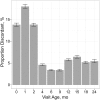Infant BMI or Weight-for-Length and Obesity Risk in Early Childhood
- PMID: 27244803
- PMCID: PMC4845873
- DOI: 10.1542/peds.2015-3492
Infant BMI or Weight-for-Length and Obesity Risk in Early Childhood
Abstract
Background: Weight-for-length (WFL) is currently used to assess adiposity under 2 years. We assessed WFL- versus BMI-based estimates of adiposity in healthy infants in determining risk for early obesity.
Methods: Anthropometrics were extracted from electronic medical records for well-child visits for 73 949 full-term infants from a large pediatric network. World Health Organization WFL and BMI z scores (WFL-z and BMI-z, respectively) were calculated up to age 24 months. Correlation analyses assessed the agreement between WFL-z and BMI-z and within-subject tracking over time. Logistic regression determined odds of obesity at 2 years on the basis of adiposity classification at 2 months.
Results: Agreement between WFL-z and BMI-z increased from birth to 6 months and remained high thereafter. BMI-z at 2 months was more consistent with measurements at older ages than WFL-z at 2 months. Infants with high BMI (≥85th percentile) and reference WFL (5th-85th percentiles) at 2 months had greater odds of obesity at 2 years than those with high WFL (≥85th percentile) and reference BMI (5th-85th percentiles; odds ratio, 5.49 vs 1.40; P < .001). At 2 months, BMI had a higher positive predictive value than WFL for obesity at 2 years using cut-points of either the 85th percentile (31% vs 23%) or 97.7th percentile (47% vs 29%).
Conclusions: High BMI in early infancy is more strongly associated with early childhood obesity than high WFL. Forty-seven percent of infants with BMI ≥97.7th percentile at 2 months (versus 29% of infants with WFL ≥97.7th percentile at 2 months) were obese at 2 years. Epidemiologic studies focused on assessing childhood obesity risk should consider using BMI in early infancy.
Copyright © 2016 by the American Academy of Pediatrics.
Conflict of interest statement
POTENTIAL CONFLICT OF INTEREST: The authors have indicated they have no potential conflicts of interest to disclose.
Figures


Similar articles
-
Association of Weight for Length vs Body Mass Index During the First 2 Years of Life With Cardiometabolic Risk in Early Adolescence.JAMA Netw Open. 2018 Sep 7;1(5):e182460. doi: 10.1001/jamanetworkopen.2018.2460. JAMA Netw Open. 2018. PMID: 30646168 Free PMC article.
-
Body Mass Index Is a Better Indicator of Body Composition than Weight-for-Length at Age 1 Month.J Pediatr. 2019 Jan;204:77-83.e1. doi: 10.1016/j.jpeds.2018.08.007. Epub 2018 Sep 26. J Pediatr. 2019. PMID: 30268397 Free PMC article.
-
Similarity of the CDC and WHO weight-for-length growth charts in predicting risk of obesity at age 5 years.Obesity (Silver Spring). 2012 Jun;20(6):1261-5. doi: 10.1038/oby.2011.350. Epub 2011 Dec 8. Obesity (Silver Spring). 2012. PMID: 22158005
-
Postnatal High Protein Intake Can Contribute to Accelerated Weight Gain of Infants and Increased Obesity Risk.Nestle Nutr Inst Workshop Ser. 2016;85:101-9. doi: 10.1159/000439492. Epub 2016 Apr 18. Nestle Nutr Inst Workshop Ser. 2016. PMID: 27088337 Review.
-
Offspring body size and metabolic profile - effects of lifestyle intervention in obese pregnant women.Dan Med J. 2014 Jul;61(7):B4893. Dan Med J. 2014. PMID: 25123127 Review.
Cited by
-
Association between Weight for Length and the Severity of Respiratory Morbidity in Preterm Infants.Children (Basel). 2024 Jan 12;11(1):91. doi: 10.3390/children11010091. Children (Basel). 2024. PMID: 38255404 Free PMC article.
-
Does Human Milk Modulate Body Composition in Late Preterm Infants at Term-Corrected Age?Nutrients. 2016 Oct 23;8(10):664. doi: 10.3390/nu8100664. Nutrients. 2016. PMID: 27782098 Free PMC article.
-
Early Life Weight Gain and Development of Childhood Asthma in a Prospective Birth Cohort.Ann Am Thorac Soc. 2018 Oct;15(10):1197-1204. doi: 10.1513/AnnalsATS.201712-921OC. Ann Am Thorac Soc. 2018. PMID: 29979628 Free PMC article.
-
Factors Differentiating Multisystem Inflammatory Syndrome in Children (MIS-C) From Severe/Critical COVID-19 Infection in Children.Indian Pediatr. 2022 Feb 15;59(2):120-124. doi: 10.1007/s13312-022-2442-4. Epub 2021 Sep 22. Indian Pediatr. 2022. PMID: 34553691 Free PMC article.
-
Evolution of nutritional status and associated factors among formula-fed infants with cow's milk protein allergy in a government program.Arch Public Health. 2023 May 12;81(1):90. doi: 10.1186/s13690-023-01094-3. Arch Public Health. 2023. PMID: 37173779 Free PMC article.
References
-
- Flegal KM, Carroll MD, Kit BK, Ogden CL. Prevalence of obesity and trends in the distribution of body mass index among US adults, 1999-2010. JAMA. 2012;307(5):491–497 - PubMed
-
- Ekelund U, Ong KK, Linné Y, et al. . Association of weight gain in infancy and early childhood with metabolic risk in young adults. J Clin Endocrinol Metab. 2007;92(1):98–103 - PubMed
-
- Stettler N, Kumanyika SK, Katz SH, Zemel BS, Stallings VA. Rapid weight gain during infancy and obesity in young adulthood in a cohort of African Americans. Am J Clin Nutr. 2003;77(6):1374–1378 - PubMed
-
- McCormick DP, Sarpong K, Jordan L, Ray LA, Jain S. Infant obesity: are we ready to make this diagnosis? J Pediatr. 2010;157(1):15–19 - PubMed
Publication types
MeSH terms
Grants and funding
LinkOut - more resources
Full Text Sources
Other Literature Sources
Medical

